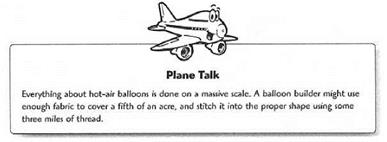The Thrill of the Chase
If you’re not in the balloon’s gondola during a flight, there’s still a lot of fun you can have as a member of the chase crew.
Chase crews are an integral part of hot-air ballooning, and there are plenty of balloon fanatics who prefer the joy of the chase to the placid dreaminess that the pilot and passengers enjoy in flight. Those who stay with a balloon crew long enough and become good enough at their job sometimes earn a special nickname—“Ace – Chase.”
|
|
Plane Talk
As a first-time balloon passenger, you’ll have a ceremonial initiation to look forward to. After your first flight you’ll stand silently in front of your experienced ballooning friends while they solemnly read this poem;
The winds have welcomed you with softness The sun has blessed you with warm hands You have flown so high and so well That God has joined you in your laughter
And has set you gently back into the loving arms of Mother Earth.
Then they’ll have you clasp your hands behind your back and lift a glass of champagne using only your mouth and your teeth. Once you drink down the champagne without spilling a drop and without usingyour hands, you’re a member of the ballooning fraternity.
At the beginning of a flight, chase crew members help haul the heavy equipment out of a truck, lay out the envelope, and help attach it to the gondola. They lay out the ropes and lines that are used to control the balloon during inflation. They attach fuel tanks to the balloon and check the few modest instruments that the pilot uses to keep tabs on the flight.
|
By the Book A balloon’s instrument* are very simple compared to an airplane’s. Generally, a balloon pilot has only an altimeter to measure height above the ground, a vertical speed indicator to display the speed of climb or descent, and a pyrometer, which measures the temperature of the air inside the balloon’s envelope. |
Chase crew members help hold the envelope open while it begins to inflate, they help passengers and pilot get settled in for the flight, and they hang on to the balloon to provide human ballast as it grows buoyant enough to take off. With an order from the pilot, the crew members release their grip on the gondola, and the balloon is on its way.
Using a combination of road maps, their own notes from scouting trips, a two-way radio linkup with the pilot, and some tips and hints from local residents, the chase crews follow the balloon across the countryside in a caravan of trucks, vans, and cars.
While balloons usually cover the ground far more slowly than a car can travel, the balloon has the advantage of getting to its destination “as the crow flies.” The chase crew, on the other hand, has to contend with traffic lights, dead-end roads, pasture gates, and unfriendly property owners who don’t share a fondness for ballooning. There are even some balloon haters out there, who may have been spoiled to the joys of the sport when unskilled or inconsiderate crews trampled their crops, damaged their property, and generally made pests of themselves.
The very best chase crews can predict the future—that is, accurately judge where the balloon might be heading, and get there first. That gives the crew time to find convenient access roads or at least to get permission from a land owner before traipsing all over his property. Pilots can help chase crews immensely by planning— and executing—a landing within easy distance of a road or vacant field.
Once the landing is made and congratulations are passed around, it’s time for the chase crew and the pilot to lay the envelope out carefully so that it can be stuffed into a bag and stored. The gondola is disassembled and hauled onto a truck. After most flights, the crew pops the cork for a champagne celebration, then heads off for a hearty breakfast to talk about the morning’s adventure.
|
Plane Talk From the striking beauty of the balloon to the memories of Jules Verne balloon adventure novels to the thrill of being so far off the ground and yet so safe and at ease, ballooning possesses an undeniably romantic quality. One unmarried woman I know once told me that she would instantly agree to marry any man who proposed to her in a balloon. Every year, hundreds of people become engaged in a hot-air balloon, and some even make headlines by being married in the gondola of a balloon. |






























